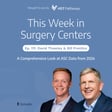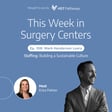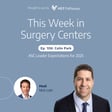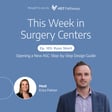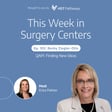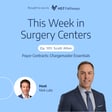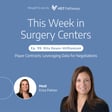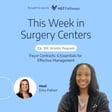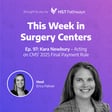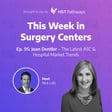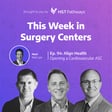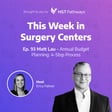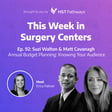Podcast Introduction
00:00:01
Speaker
Welcome to This Week in Surgery Centers. If you're in the ASC industry, then you're in the right place. Every week, we'll start the episode off by sharing an interesting conversation we had with our featured guests, and then we'll close the episode by recapping the latest news impacting surgery centers. We're excited to share with you what we have, so let's get started and see what the industry's been up to.
Interview Preview: Michael McLean on Payer Contracts
00:00:27
Speaker
Hi, everyone. Here's what you can expect on today's episode. So last week, we sat down with Will Schlaf to talk about how to conduct a feasibility assessment for your new surgery center. As a continuation of that conversation, today we're sitting down with Michael McLean to talk about navigating payer contracts for your new surgery center.
00:00:49
Speaker
Michael is the founder and managing member at Left Coast Healthcare Advisors, and we are going to talk through how to initiate these payer conversations, positioning yourself to get the best rates, effectively managing contracts, and so much more in the payer contract world.
News Highlights: Nursing Workforce and ASC Safety
00:01:06
Speaker
In our news recap, we'll cover the government's plan to grow the nursing workforce, how to implement more safety and security measures at your ASC, the use of machine learning to predict the suitability for having a surgical procedure performed at an ASC versus a HOPD, and of course, end the new segment with a positive story about how many steps a day you actually need to remain healthy.
00:01:33
Speaker
Hope everyone enjoys the episode and here's what's going on this week in surgery centers.
Payer Contract Negotiations: When to Start?
00:01:42
Speaker
Michael, welcome to the show. Thank you for having me. Excited to have you on today and we've been doing a series of podcasts and conversations recently on the de novo process and opening new surgery centers. And so.
00:01:55
Speaker
Wanted to continue that conversation on here today, Michael, and bend it towards the payer contract side of opening new facilities. And so as you think about the process open new ASCs and you think about payer contracting, when do those negotiations come up in the overall timeline of opening a surgery center?
Demonstrating Value to Payers in ASC Contracts
00:02:20
Speaker
Yeah, the question of how you start that process and where it starts really depends on the value proposition that your ASC brings to the payer. In concept, an ASC should be a lower cost, higher quality location of service than one where patients are coming from.
00:02:40
Speaker
But the level of that value to the payer varies. Is this an ASC that bringing an exceptionally large amount of business from say a hospital or other locations where the rates are much higher, payers are much more interested in engaging in that conversation that shortens your timeline. So I always advocate thinking at least six to nine months out before you're opening to begin addressing your payer contracts.
Gathering Market Insights on Payers
00:03:06
Speaker
Six to nine months. Great.
00:03:09
Speaker
And for owners and for folks working on building out new facilities, how do you get the lay of the land in your market in terms of who the payers might be, what the most important payers might be by type and by volume? Is there a way that you can research and get up to speed on these things before you start reaching out?
00:03:29
Speaker
Yeah, great question.
Understanding Payer Rates and Cost Coverage
00:03:30
Speaker
There are a number of ways to do it. Although ironically, the most effective is still secret shopping, picking up the phone, calling competitors from different phones and asking them what they charge or what the expense would be. There are more software platforms that are now coming out on the market and with all the changes in the No Surprises Act and with changes around hospital and pricing transparency, there are more resources available.
00:03:56
Speaker
Honestly, the single best location of information though is patient EOBs, whether that's families, friends, your physicians who are going to be in your new ASC. Their patients are getting EOBs from wherever they're doing cases today and will have exactly what the insurance providers are paying. That gives you a great armchair metric to establish what your savings can look like and the value that you offer to a payer.
Strategies for Negotiating Rates
00:04:24
Speaker
Guys, you're almost suggesting starting to put together kind of the point of view on, hey, who are these payers that are going to benefit based on your potential patients and who those are going to be? Who are the payers that are common and stand to gain the most from your services coming to market?
00:04:40
Speaker
Absolutely. I always think about payers. When you think about a payer contract, it's the most important piece of your ambulatory strategy when you're building an ASC was it's all the dollars at the top fall to the bottom line. And so while many payers will provide a contract, getting premium rates where you're paying for your costs plus a margin,
00:05:03
Speaker
take time and data. And so you want to be really strategic about that and understanding where is the leverage that you can apply to that conversation so that you get the most appropriate rate for the cost savings, because it's not going to get offered in the first proposal that you get on your desk. Sure. To that point, it seems like really this is one of the most fundamental, important concepts of opening and maintaining a profitable ESC for the long term.
00:05:36
Speaker
revenue, right? And again, if we put ourselves in the shoes of new ASC owners, they're researching their patient demographic, getting a feel for the market, formulating their value prop and their pitch. When they're ready to start reaching out to payers, what do you recommend that folks do? And what should they keep in mind as they start to initiate those conversations and start to initiate those negotiations?
Credentialing and Rate Negotiations
00:06:05
Speaker
Yeah, I think the key message is you're only going to get to sign your first contract once. And so every subsequent contract will be renegotiating and trying to get more. So that first contract is incredibly important. So as you're thinking about, gosh, we're six to nine months from opening.
00:06:22
Speaker
starting the conversations with the physician representatives, that each practice has a representative from the payer that's a market representative and saying, hey, we're going to be moving our volume over to a new ASC. Help us start to get in contact with the ASC specific negotiators for each payer. Understanding that there are two processes. You have to negotiate rate and terms, but you also have to complete credentialing.
00:06:49
Speaker
And so the credentialing application itself can sometimes take two to three months and often requires that you have both your license and your Medicare certification number before they'll let you complete credentialing. So even if you're negotiating rates, you may not be able to complete that credentialing piece and both have to happen and then allow for contract loading so you have time to get paid.
00:07:14
Speaker
So it's critical, I think, to think ahead about who are your most important payers at the time of opening. Begin those conversations early. You can have conversations with smaller payers in the market, but then lose your large national payers that'll have larger volume. Start those conversations first and know that the rates that you sign with them will cascade downward to the smaller payers.
00:07:40
Speaker
Got it. And you mentioned the payer conversations and credentialing is two key milestones. It sounds like it's okay to run those two processes in parallel or are they more sequential? So it depends on the payer and it depends on the market. And we always say healthcare is local. It's really true when it comes to reimbursement and payer process. Many payers will tell you they will not negotiate.
00:08:04
Speaker
until they have a credentialing packet complete. And if you don't have a Medicare certification, you can't complete your application. That being said, most payers will allow if you push a bit for you to at least put documentation in queue so that you can at least provide the bulk of the credentialing information early.
00:08:26
Speaker
even if you're still working on rates, but they're actually two completely separate divisions in every payer. Every payer has a credentialing department and a negotiations or payer department. And so it's actually two different groups of people that you work with. So if you approach it sequentially, you're just adding time. So I always advocate push as hard as possible to get them going simultaneously.
00:08:52
Speaker
Okay, that's good to know from an order of operations perspective. And you mentioned on the negotiation side that there's the rate side of that negotiation and the term side. And if we kind of break those up, let's talk about the rate side first. What is the best way? Healthcare is local. Are rates local too?
Local Rate Benchmarks and Negotiation Process
00:09:09
Speaker
What's the best way for owners to get an understanding of what rates are benchmark, what rates are fair, what rates are normal in their market?
00:09:17
Speaker
So you're absolutely right. Rates vary by market. They can even vary by micro market, meaning one side of the state will have a completely different rate than the other. You can get a little bit of feel for that by looking at what your Medicare rate is in each market, because Medicare publishes all their standard rates. And there's variations based on population, cost of living, et cetera. So you know that you're going to have some variation.
00:09:44
Speaker
When it comes to individual rates though, I would say that the individual rate that you have the ability to negotiate, payers like to think of rate in terms of what they're paying everyone else. You as an owner of an ASC should be thinking of what am I saving the payer by providing this service and causing a migration of cases from point A to point B.
00:10:09
Speaker
That work that we talked about earlier, understanding the EOBs, what are your area hospitals or ASCs being paid, whether you're querying through existing software and other pricing transparency tools to get a feel for that rate. Where do you fit into that is how you start to determine your rate. But in the end, the rate that's most important is the one that covers your costs.
00:10:34
Speaker
So you really need to understand if my procedure costs $5,000 to perform, I shouldn't ever accept a rate that's less than $5,000. And so I think that's the key is understanding what your expenses are so you can effectively negotiate a payment plus a margin because you're going to need to continually reinvest in those ASCs.
00:10:58
Speaker
And what is a reasonable margin that also varies by market. There are plenty of markets where rates are at or below Medicare from a commercial construct. And you'll understand that by talking to your ASC colleagues in the market. Oh, yeah, I'll never, I can't get more than X. Other markets, you look at some areas in the Midwest, some areas in Texas, some more rural areas, they may still have rates that are two, three, four times Medicare.
00:11:27
Speaker
And so getting that understanding of what the larger market is and then honing in on what do I need as a business to grow. Okay. Got it. And then these actual conversations on the right side, as you mentioned, these are important conversations and the negotiations, arguably nothing's more important as you get going. Is there a framework or set of best practices or a playbook in terms of how people
00:11:54
Speaker
drive these conversations? Should folks expect that this is going to be a series of a 10 step negotiation? Do people settle this in a call or two if they're prepared? What's like the range of processes that you've seen for this? What I would say is the higher above what is considered a market rate. And once you've done your homework and figured out, okay, the market rate for this is somewhere between 2,000 and 3,000 dollars. The higher
00:12:23
Speaker
above that market rate that you want to get and the size of the payer will dictate how many rounds or how long it's going to take to do that negotiation. If you want double the market rate, that type of negotiation could take a year and could take a thousand man hours and lots of negotiations. You might not ever get there. If you're looking to accept a market rate from a small payer who's just trying to get in the door, that could happen as quickly as in a phone call.
00:12:52
Speaker
And you get a relatively decent proposal for a relatively small amount of business. So I think the most important part though, from this, it's not a 12 step program, which is great. Although sometimes you feel like it is, is that the very first thing you should do is make sure that when you're negotiating, you get an entire fee schedule.
00:13:13
Speaker
so that the payer provides you every single payment for every single CPT. Because without that information, you're guessing.
Fee Schedules and Additional Services in Contracts
00:13:23
Speaker
And so that should be the first step of every discussion is to get the actual fee schedule that they will pay you or that they're basing their rates on. The second thing that I think is really important is to really target what additional services are they going to bring? Are they going to reimburse implants? Do they provide carve outs? What are the special elements that might be there? And then the devil's in the detail when it comes to things like multiple procedure logic.
00:13:53
Speaker
Some payers will pay 100% of the first procedure you do and then 50% of all the subsequent. Others only pay 100 on the first 50 on the second 25 and the third and then nothing else. And so understanding the differences, every payment system is different. That's why it's so important to get all of that information upfront so then you can effectively negotiate with them.
00:14:19
Speaker
at multiple procedure logic in particular. That's where it gets complicated, isn't it? Absolutely. If you're an ENT practice, for example, and you typically have six or seven or eight procedures that you do at once, that's a very different reimbursement model than say ophthalmology that is mostly Medicare and generally has only one procedure code.
00:14:43
Speaker
So multiple procedures matter a lot more to an ENT or orthopedic practice than they might with a more typical urology or general surgery practice. Yep. Those are good tips around the fee schedule, additional services and the multiple procedure logic, but it's a lot to get your head around if you're doing this for the first time. If you're not an expert in this process and it's daunting to get through the first time, I'm sure.
00:15:09
Speaker
What have you seen out there as great resources, great firms, great people that folks, owners, opening de novos can talk to for help as they go through this? Sure. And I think that sort of comes in what I would say three flavors. I think the first one is your own professional organizations, whether it's a state professional ASC or a state professional physician practice organization, they're going to have access to the local talent that is going to be able to help.
00:15:36
Speaker
whether it's a consultant or even just a network of people to compare and contrast ideas and comments. I think that's the first great step. The second is really engaging more of a formal consulting or advisory firm. I know my firm, West Coast Healthcare Advisors, we offer that services and tend to focus more on the West Coast, but we've got experience across the country.
00:15:57
Speaker
And there are other great firms that are small like us that offer some similar size services, I think of. There's probably a few others. And then there's a third layer, and I think this is particularly important if you're starting a really large or capital intense ASC. If you're looking at hospital joint venture relationships, if you're looking at large specialty practices,
00:16:22
Speaker
Sometimes you can benefit from an even more deep dive in companies like ECG and SG2. There are big consulting firms. What I would say is that the output generally is equal to the cost that you're going to pay. But I also think that if you're looking for $100,000 increase every year on a contract,
00:16:47
Speaker
The cost to pay $40,000 or $50,000 seems horribly daunting, but that's $100,000 a year to the bottom line every year in perpetuity that they helped you get. So it's really starting at that local level. Is there someone locally that can help you? If not, is there a larger organization that might benefit? And of course, there's no shortage of organizations around rev cycle companies, nimble surgical notes, others that can help.
00:17:17
Speaker
With negotiating contracts as part of the recycle service, because they do a lot of options. Yeah. And we touched on the rate side. And one thing I actually forgot to touch on more was the key term side outside of rates is folks are setting up these bear contracts. What should they be thinking about or watching out for on the term side?
00:17:35
Speaker
Yeah, we touched on rate and multiple procedure logic. Termination provisions are really
Key Contract Terms: Termination and Lesser of Provision
00:17:41
Speaker
important. How long is the contract and what are the rights that you have in terms of terminating it? Surprisingly, termination language can be long. Some payers say as long as you have to tell them you're going to terminate 180 days before the contract's over. Most of us, I certainly don't think six months in advance when I'm running an ASE,
00:18:03
Speaker
That I have to negotiate essentially nine months in advance, because if I can't get somewhere and I want to terminate in the future, I need to give them six months notice so term and termination matters a whole lot. I think the other two that are particularly important now are really around amendment language.
00:18:20
Speaker
and assignment language, if you're looking at a potential sale in the future, those contracts go with you or not. It's a really important question to understand because in an acquisition or a partnership, if someone's coming into your facility, they want to know, can we bring those contracts along for the ride or do we need to start over?
00:18:41
Speaker
And I got to imagine on that point of assignment and acquisitions, sometimes it's probably helpful for the centers to have agreements that are assignable to the next group. And maybe sometimes you have groups that come in that would rather negotiate their own because they have a big infrastructure and in place contracts. You're absolutely correct. It's part of that larger question of what will a future partnership look like from an M&A standpoint. Maybe you want to maintain your existing contracts. Maybe you don't, you want to start over.
00:19:11
Speaker
Depending on what the new partner brings to you. The other piece that I think gets lost a lot of time is the difference between charge and payment and understanding is there a lesser of provision that sits in there that lesser of provision in the market that we chat about is really.
00:19:27
Speaker
Are they going to pay you the lesser of a contracted rate or a billed charge amount? And quite often there are ways that if you aren't charging high enough on your contract, they won't automatically pay you your contract rate. Maybe they pay you 50% of billed charges or the lesser of that or your contracted rate. So your charges have to be high enough to capture that contracted rate. Sure. And how should folks think about in-network
00:19:56
Speaker
versus out of network and how that comes into play from a high level. Yeah. Oh gosh. So I've been saying for almost 15 years that out of network services is going away. And yet every day we still have out of network services.
00:20:12
Speaker
And so what I would say is understanding what your local and state laws are around out-of-network services. Now that we've got the No Surprises Act, I'm actually doing a talk on that coming up, around what do you have to disclose now to the patients if they are choosing to go out-of-network or have non-insurance coverage.
00:20:35
Speaker
So I think the biggest thing to do is really do your homework locally, understand your state and local regulations around what information is going to be there or has to be provided to the patient. I think that's so important because I think it's difficult to manage out-of-network practices and now it's even more. Okay, final question for you here, Michael. We do this every week with our guests. What's one thing our listeners can do this week to improve their surgery centers?
Enhancing Patient Experience at ASCs
00:21:01
Speaker
I saw that question and I thought quite a bit about it. And I go back to my days as an operator. The best thing I ever did in my ASC, and I've had all my people do this, is to have someone in your ASC wheel you around either in a wheelchair or in a stretcher. And your perspective changes entirely. You get to see the ceiling. You get to see what it's like to go through doors. You get an entirely different view of your own facility.
00:21:29
Speaker
it's amazing if you're laying in the back on your back in your own pack you what you see above you remember that's what patients see every day and you can really dramatically change the look and feel of your facility by changing a few ceiling tiles or catching a few cobwebs that's the best thing that I've ever and I was taught that by an older asc expert and I've done it every time I think it's great
00:21:55
Speaker
Wow. That's a different answer than we've ever gotten before answering this question. I love it from a patient experience standpoint. Thanks for sharing that. You bet. Michael, thanks for joining us today. Absolutely. Thanks for having me. As always, it has been a busy week in healthcare, so let's jump right in.
HRSA's Investment in Nursing Training
00:22:17
Speaker
The Health Resources and Services Administration announced awards of more than $100 million to train more nurses and grow the nursing workforce. So the $100 million will be spread out between three different areas of focus. The first is helping licensed practical nurses become registered nurses.
00:22:40
Speaker
So $8.7 million of the hundred million will be given, now this is the longest name ever, but will be given to the nurse education practice quality and retention pathway to registered nurse program, which trains practical and vocational nurses to become registered nurses.
00:23:01
Speaker
The second focus will be on training nurses who will deliver primary care, mental health care, and maternal health care. Now, this is by far where the biggest portion of the money will be going, and there are two programs that will benefit here.
00:23:17
Speaker
$34.8 million will be given to the Advanced Nursing Education Workforce Program. And then $30 million will be given to the Advanced Nursing Education Nurse Practitioner Residency and Fellowship Program.
00:23:34
Speaker
And then lastly, the third and final focus will be on addressing the bottlenecks in nurse training by supporting more nurse faculty. So the remaining 26.5 million will be given to the nurse faculty loan program to provide low interest loans and loan cancellation to incentivize careers as nursing school faculty.
00:23:57
Speaker
So Carol Johnson is the HRSA's administrator and she said, today's investments demonstrate our ongoing commitment to supporting the nursing workforce, training and growing the next generation of nurses, creating career ladders for nurses and recognizing the critical role nurses play in primary mental and maternal healthcare. Now, a hundred million dollars is great. We'll take it. You know, compared to the government's budget, it's not much.
00:24:27
Speaker
but better than nothing. And if you want to learn more about these programs, check out hhs.gov or head to these episode notes and you'll find a link directly to the article and you can learn more about the programs and see how you might be able to benefit.
Security and Safety in Surgery Centers
00:24:44
Speaker
Our second story comes from the August edition of ASC Focus, and it's all about implementing security and safety measures at your surgery center. So the most recent federal data from the Bureau of Labor Statistics states that healthcare and social service industries experience the highest rate of injuries caused by workplace violence
00:25:07
Speaker
and are five times as likely to suffer a workplace violence injury than workers overall. And then a National Nurses United survey of more than 2,500 nurses that was conducted in early 2022
00:25:23
Speaker
found that nearly half reported an increase in workplace violence. So I share all of this because this is why it feels so timely as you probably have experience in your own day-to-day workplace environments that, especially after COVID and during the pandemic, there's just been an increase of unruly patients and issues that are taking place. So where can you start?
00:25:47
Speaker
by conducting a security vulnerability assessment to identify potential security gaps and the actions that can be taken to address them. This assessment should be as comprehensive as possible and include interviews with leadership and frontline associates as they can likely identify vulnerabilities and make the best suggestions for improvement.
00:26:09
Speaker
So the article shared a ton of different ideas from a few different administrators who have recently been focused on added safety measures. And here's a quick recap of what they did share. So you'll want to double check and possibly upgrade the locking mechanisms on all doors and windows. Hire part-time off-duty police officers to help keep patients and visitors under control.
00:26:34
Speaker
Install keypads so that visitors are unable to move past the waiting room unattended. Add security cameras outside your facility. Install a silent alarm system so you can alert local police. And then lastly, make sure your employees are properly trained for any situation or emergency and that everyone is well equipped and in the know about your emergency preparedness plans.
00:27:02
Speaker
And hopefully you will never need to act on any of these safety measures and it will always seem like overkill, but it's just not one area you want to be caught off guard. And if you haven't done an evaluation like this, it's a great place to start and then they recommend doing it annually moving forward.
00:27:22
Speaker
Our third story comes from OR Manager, and it's about a study from the University of Michigan that examined the use of machine learning to predict the suitability for having a surgical procedure performed at an ASC versus a hospital outpatient department.
Machine Learning in ASC Procedure Suitability
00:27:40
Speaker
So when the process is done manually, it's pretty labor intensive and requires physician assistants to review each patient's suitability one by one.
00:27:49
Speaker
The machine learning model has two components. The first is predicting the outcome of a clinician review for where a patient is best suited for having their procedure at. And then the second is for predicting whether the surgical procedure will be done at an ASC or a hop deep.
00:28:07
Speaker
And the models were trained using roughly 30,000 clinician reviews and surgical location types. And after the study was complete, the researchers estimated that using the model-based reviews at their institution would save about 80 hours per week, which is obviously equivalent to two full-time clinical employees.
00:28:28
Speaker
Now, I will give the same disclaimer I do every time we share a story about AI and healthcare. This technology is intended to be used in tandem with medical professionals, not in lieu of. But this seems like this might be one area where you can use simple
00:28:45
Speaker
learnings and if-then type logic to build a reliable and helpful model that will save lots of time and help PAs spend more of their time providing care on more complex scenarios.
Health Benefits of Fewer Daily Steps
00:28:59
Speaker
And to end our new segment on a positive note, no pressure to walk 10,000 steps a day anymore. A new analysis revealed that health benefits kick in at as few as 2,300 steps per day, while 4,000 steps is enough to cut the risk of premature death.
00:29:18
Speaker
So researchers in Poland analyzed step count involving almost 227,000 people. They found that those who took 2,337 steps a day experienced benefits to the heart and blood vessels, while walking at least 3,967 steps reduced the risk of dying from any cause. And lastly, every 1,000 steps over that 4,000 mark
00:29:47
Speaker
cut the chance of early death by 15%. It's also important to note that this applied to both men and women of all ages and outdoor living environments. So while walking and added movement should always still be the goal, if you don't hit that 10,000 number every day, seems like it's okay.
00:30:05
Speaker
And that news story officially wraps up this week's podcast. Thank you as always for spending a few minutes of your week with us. Make sure to subscribe or leave a review on whichever platform you're listening from. I hope you have a great day and we'll see you again next week.

